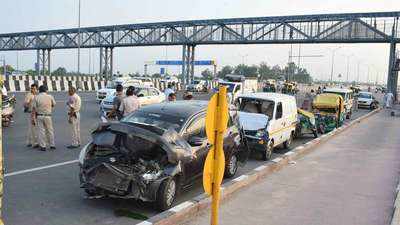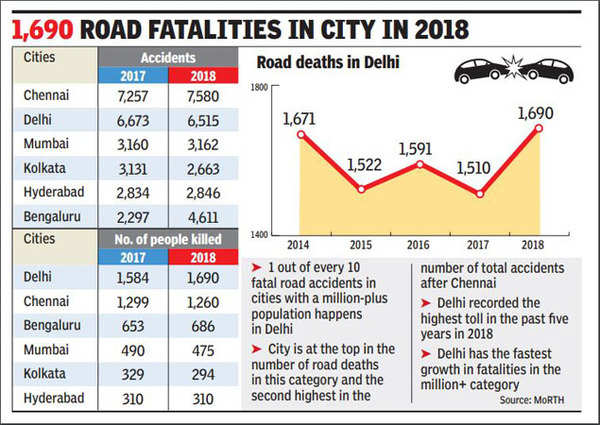- News
- City News
- delhi News
- Delhi recorded a death in road accidents every five hours last year
Trending
This story is from November 17, 2019
Delhi recorded a death in road accidents every five hours last year
Of every 10 fatal road accidents in Indian cities with a population of over one million, one is in Delhi. The toll in the city hit the highest mark in the past five years in 2018. According to an accident report brought out by the Union ministry of road transport and highways, Delhi suffered a road death almost every five hours last year.

Aerial view of Delhi
NEW DELHI: Of every 10 fatal road accidents in Indian cities with a population of over one million, one is in Delhi. The toll in the city hit the highest mark in the past five years in 2018. According to an accident report brought out by the Union ministry of road transport and highways, Delhi suffered a road death almost every five hours last year.
There were a total of 17,709 road deaths in million-plus cities in 2018.Of this, the toll in Delhi was 1,690, far higher than in Mumbai or Kolkata, where 475 and 294 deaths were recorded, respectively.

Delhi tops in the number of road deaths among such cities and is second after Chennai for number of accidents. Delhi also showed the fastest growth, or fatalities as a ratio of total road accidents. The ministerial report also said that cities with populations of over 50 million, Delhi being one such, accounted for 18.3% of the total number of accidents and 11.7% of fatalities.
Piyush Tewari, member of Save Life Foundation who has been campaigning for safer roads, observed that the number of fatalities was directly proportional to the enforcement of traffic rules. “Besides speeding and driving under the influence, we discovered there was a spurt in wrong-side driving, resulting in more accidents. Prosecution against violations has to be increased,” he said.
Tewari also added that Delhi lacked a robust accident trauma care system. “Though an ambulance service exists and good Samaritans helping accident victims are rewarded, the police control room van is still the sole unit that responds within the golden hour. Road fatalities can be reduced if this is properly systemised,” he said.
An earlier Delhi traffic police report had cited human factors and defective and insufficient road designs as reasons for the increase in accidents and fatalities. For instance, defective road designs were deemed to behind 40% of the accidents due to unguarded civic works and 20% attributed to bumpy roads or potholes. Poor illumination was the cause of 33% of the accidents.
P K Sarkar, formerly professor of transport planning at the School of Planning and Architecture, pointed out that apart from stronger enforcement, vehicle management at night should be a priority for the traffic police and civic agencies. “Earlier, steps were taken to reduce the speed of vehicles on highways and emptier stretches after 9pm till 6am, considered the deadliest hours for accidents,” Sarkar said. “If not present physically, police can rely on technology to monitor the speeds of vehicles in this period. We should see changes in the fatality figures after the Intelligent Traffic Management System being installed becomes fully operational.”
There were a total of 17,709 road deaths in million-plus cities in 2018.Of this, the toll in Delhi was 1,690, far higher than in Mumbai or Kolkata, where 475 and 294 deaths were recorded, respectively.

Delhi tops in the number of road deaths among such cities and is second after Chennai for number of accidents. Delhi also showed the fastest growth, or fatalities as a ratio of total road accidents. The ministerial report also said that cities with populations of over 50 million, Delhi being one such, accounted for 18.3% of the total number of accidents and 11.7% of fatalities.
Dense population and congested vehicular movement are causes of road accidents in Delhi. Explaining why 2018 had the highest toll of lives in the last five years, S Velmurugan of the Central Road Research Institute said, “Last year a number of road stretches reopened for traffic after the construction activities were completed and the average speed on the road increased. This could have resulted in fatal accidents.”
Piyush Tewari, member of Save Life Foundation who has been campaigning for safer roads, observed that the number of fatalities was directly proportional to the enforcement of traffic rules. “Besides speeding and driving under the influence, we discovered there was a spurt in wrong-side driving, resulting in more accidents. Prosecution against violations has to be increased,” he said.
Tewari also added that Delhi lacked a robust accident trauma care system. “Though an ambulance service exists and good Samaritans helping accident victims are rewarded, the police control room van is still the sole unit that responds within the golden hour. Road fatalities can be reduced if this is properly systemised,” he said.
An earlier Delhi traffic police report had cited human factors and defective and insufficient road designs as reasons for the increase in accidents and fatalities. For instance, defective road designs were deemed to behind 40% of the accidents due to unguarded civic works and 20% attributed to bumpy roads or potholes. Poor illumination was the cause of 33% of the accidents.
P K Sarkar, formerly professor of transport planning at the School of Planning and Architecture, pointed out that apart from stronger enforcement, vehicle management at night should be a priority for the traffic police and civic agencies. “Earlier, steps were taken to reduce the speed of vehicles on highways and emptier stretches after 9pm till 6am, considered the deadliest hours for accidents,” Sarkar said. “If not present physically, police can rely on technology to monitor the speeds of vehicles in this period. We should see changes in the fatality figures after the Intelligent Traffic Management System being installed becomes fully operational.”
End of Article
FOLLOW US ON SOCIAL MEDIA










